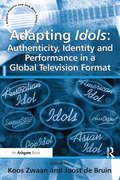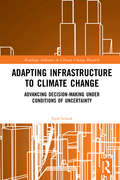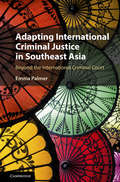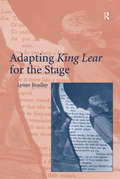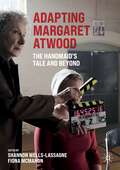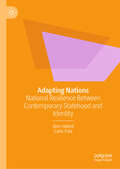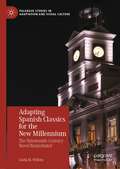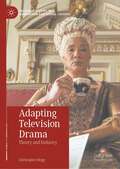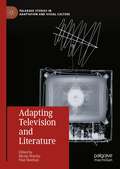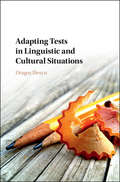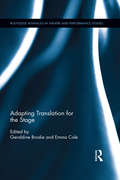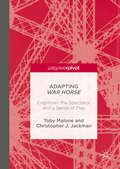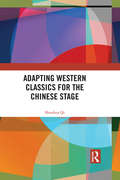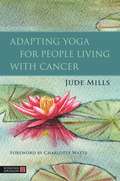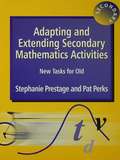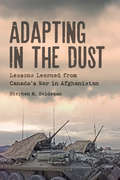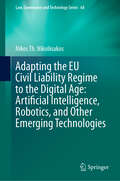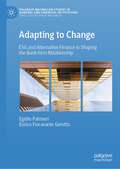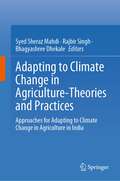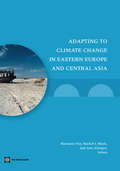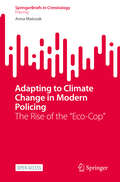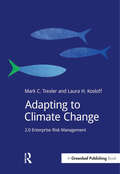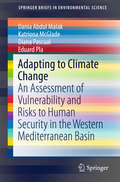- Table View
- List View
Adapting Idols: Authenticity, Identity And Performance In A Global Television Format (Ashgate Popular and Folk Music Series)
by Joost de BruinSince the first series of Pop Idol aired in the UK just over a decade ago, Idols television shows have been broadcast in more than forty countries all over the world. In all those countries the global Idols format has been adapted to local cultures and production contexts, resulting in a plethora of different versions, ranging from the Dutch Idols to the Pan-Arab Super Star and from Nigerian Idol to the international blockbuster American Idol. Despite its worldwide success and widespread journalistic coverage, the Idols phenomenon has received only limited academic attention. Adapting Idols: Authenticity, Identity and Performance in a Global Television Format brings together original studies from scholars in different parts of the world to identify and evaluate the productive dimensions of Idols. As one of the world's most successful television formats, Idols offers a unique case for the study of cultural globalization. Chapters discuss how Idols shows address particular national or regional identity politics and how Idols is consumed by audiences in different territories. This book illustrates that even though the same television format is used in countries all over the globe, practices of adaptation can still result in the creation of unique local cultural products.
Adapting Infrastructure to Climate Change: Advancing Decision-Making Under Conditions of Uncertainty (Routledge Advances in Climate Change Research)
by Todd SchenkMany of the challenges that decision-makers grapple with in relation to climate change are governance related. Planning and decision-making is evolving in ambiguous institutional environments, in which many key issues remain unresolved, including relationships between different actors; funding arrangements; and the sources and procedures for vetting data. These issues are particularly acute at this juncture, as climate adaptation moves from broad planning processes to the management of infrastructure systems. Concrete decisions must be made. Adapting Infrastructure to Climate Change draws on case studies of three coastal cities situated within very different governance regimes: neo-corporatist Rotterdam, neo-pluralist Boston and semi-authoritarian Singapore. The book examines how infrastructure managers and other stakeholders grappling with complex and uncertain climate risks are likely to make project-level decisions in practice, and how more effective decision-making can be supported. The differences across governance regimes are currently unaccounted for in adaptation planning, but are crucial as best practices are devised. These lessons are also applicable to infrastructure planning and decision-making in other contexts. This book will be of great interest to scholars of climate change and environmental policy and governance, particularly in the context of infrastructure management.
Adapting Interactive Learning Environments to Student Competences: The Case for Complex Dynamic Systems (SpringerBriefs in Educational Communications and Technology)
by Aklilu Tilahun Tadesse Pål Ingebright Davidsen Erling MoxnesThis monograph focuses on the design of personalized and adaptive online interactive learning environment (OILE) to enhance students’ learning in and about complex dynamic systems (CDS). Numerous studies show that students experience difficulties when learning in and about CDS. The difficulties are due to challenges originating from a) the structural complexity of CDS, (b) the production of dynamic behavior from the underlying systems structure, and (c) methods, techniques and tools employed in the analysis of such systems. Despite the fact that studies have uncovered such learning challenges, it is still not well understood how we may effectively address these challenges. In this monograph, the authors provide some answers as to how we may best improve our cognitive capabilities to meet these challenges by way of effective instructional methods, techniques, and tools and their implementation in the form of an OILE. The OILE developed for this purpose, builds on a five-step holistic instructional design framework; identification of instructional design models, identification of authentic learning material, identification of instructional methods, identification of instructional techniques, and design of the interface and implementation of the tool. In this OILE development, six well-documented instructional design models were considered; a four component instructional design, first principles of instruction, constructivists learning environment, task centered instruction, cognitive apprenticeship, and elaboration theory.
Adapting International Criminal Justice in Southeast Asia: Beyond the International Criminal Court
by Emma PalmerHow is international criminal law adapted across time and space? Which actors are involved and how do those actors seek to prosecute atrocity crimes? States in Southeast Asia exhibit a range of adapted approaches toward prosecuting international crimes. By examining engagement with international criminal justice especially in Cambodia, the Philippines, Indonesia, and Myanmar, this book offers a fresh and comprehensive approach to the study of international criminal law in the region. It nuances categories of the 'global' and 'local' and demonstrates how norms can be adapted in multiple spatial and temporal directions beyond the International Criminal Court. It proposes a shift in the focus of those interested in international criminal justice toward recognising the opportunities and expertise presented by existing adaptive responses to international crimes. This book will appeal to scholars, practitioners and advocates interested in international criminal law, international relations, transitional justice, civil society, and law in Southeast Asia.
Adapting King Lear for the Stage
by Lynne BradleyQuestioning whether the impulse to adapt Shakespeare has changed over time, Lynne Bradley argues for restoring a sense of historicity to the study of adaptation. Bradley compares Nahum Tate's History of King Lear (1681), adaptations by David Garrick in the mid-eighteenth century, and nineteenth-century Shakespeare burlesques to twentieth-century theatrical rewritings of King Lear, and suggests latter-day adaptations should be viewed as a unique genre that allows playwrights to express modern subject positions with regard to their literary heritage while also participating in broader debates about art and society. In identifying and relocating different adaptive gestures within this historical framework, Bradley explores the link between the critical and the creative in the history of Shakespearean adaptation. Focusing on works such as Gordon Bottomley's King Lear's Wife (1913), Edward Bond's Lear (1971), Howard Barker's Seven Lears (1989), and the Women's Theatre Group's Lear's Daughters (1987), Bradley theorizes that modern rewritings of Shakespeare constitute a new type of textual interaction based on a simultaneous double-gesture of collaboration and rejection. She suggests that this new interaction provides constituent groups, such as the feminist collective who wrote Lear's Daughters, a strategy to acknowledge their debt to Shakespeare while writing against the traditional and negative representations of femininity they see reflected in his plays.
Adapting Margaret Atwood: The Handmaid's Tale and Beyond (Palgrave Studies in Adaptation and Visual Culture)
by Shannon Wells-Lassagne Fiona McMahonThis book engages with Margaret Atwood’s work and its adaptations. Atwood has long been appreciated for her ardent defence of Canadian authors and her genre-bending fiction, essays, and poetry. However, a lesser-studied aspect of her work is Atwood’s role both as adaptor and as source for adaptation in media as varied as opera, television, film, or comic books. Recent critically acclaimed television adaptations of the novels The Handmaid’s Tale (Hulu) and Alias Grace (Amazon) have rightfully focused attention on these works, but Atwood’s fiction has long been a source of inspiration for artists of various media, a seeming corollary to Atwood’s own tendency to explore the possibilities of previously undervalued media (graphic novels), genres (science-fiction), and narratives (testimonial and historical modes). This collection hopes to expand on other studies of Atwood’s work or on their adaptations to focus on the interplay between the two, providing an interdisciplinary approach that highlights the protean nature of the author and of adaptation.
Adapting Nations: National Resilience Between Contemporary Statehood and Identity
by Carlo Pala Alon HelledNations adapt. Nations are resilient both within and outside the boundaries of statehood. Yet scholarship tends to downplay nationhood, as it focuses on the polity. As a consequence, the investigation of modern societies, though usually articulated around the nation-state model, falls into state-centrism, whilst neglecting the other side of the coin. This book initiates an interdisciplinary debate that encourages research in a field that has largely been overlooked in European social and political sciences. The analysis, offered by the authors, reinstates the concept of the 'nation' beyond the traditional, and somewhat dichotomous, schools of thought, hence neither judging the nation as a mere invention nor as a deterministic product of history. The book provides those interested in nationalism with new approaches to exploring national identity and its connection to statehood. By using concepts inspired by political science and sociology, namely habitus, survival unit, polity, hysteresis, and so forth, the different chapters of the volume revitalise the inquiry of the dimensions and features in which the nation and the identification they engender become tools of adaptation in relation to the transformative reality of our own contemporaneity. The authors thus contextualise the latter via the mid-range concept of national resilience at both meso- and macro-levels.
Adapting Psychological Tests and Measurement Instruments for Cross-Cultural Research: An Introduction
by Vladimir HedrihAdapting Psychological Tests and Measurement Instruments for Cross-Cultural Research provides an easy-to-read overview of the methodological issues and best practices for cross-cultural adaptation of psychological instruments. Although the development of cross-cultural test adaption methodology has advanced in recent years, the discussion is often pitched at an expert level and requires an advanced knowledge of statistics, psychometrics and scientific methodology. This book, however, introduces the history and concepts of cross-cultural psychometrics in a pedagogic and simple manner. It evaluates key ethical, cultural, methodological and legal issues in cross-cultural psychometrics and provides a guide to test adaptation, data analysis and interpretation. Written in an accessible manner, this book builds an understanding of the methodological, ethical and legal complexities of cross-cultural test adaptation and presents methods for test adaptation, including the basic statistical procedures for evaluating the equivalence of test versions. It would be the ideal companion for undergraduate students and those new to psychometrics.
Adapting Spanish Classics for the New Millennium: The Nineteenth-Century Novel Remediated (Palgrave Studies in Adaptation and Visual Culture)
by Linda M. WillemThe twenty-first-century's turn away from fidelity-based adaptations toward more innovative approaches has allowed adapters from Spain, Argentina, and the United States to draw upon Spain's rich body of nineteenth-century classics to address contemporary concerns about gender, sexuality, race, class, disability, celebrity, immigration, identity, social justice, and domestic violence. This book provides a snapshot of visual adaptations in the first two decades of the new millennium, examining how novelistic material from the past has been remediated for today's viewers through film, television, theater, opera, and the graphic novel. Its theoretical approach refines the binary view of adapters as either honoring or opposing their source texts by positing three types of adaptation strategies: salvaging (which preserves old stories by giving them renewed life for modern audiences), utilizing (which draws upon a pre-existing text for an alternative purpose, building upon the story and creating a shift in emphasis without devaluing the source material), and appropriation (which involves a critique of the source text, often with an attempt to dismantle its authority). Special attention is given to how adapters address audiences that are familiar with the source novels, and those that are not. This examination of the vibrant afterlife of classic literature will be of interest to scholars and educators in the fields of adaptation, media, Spanish literature, cultural studies, performance, and the graphic arts.
Adapting Television Drama: Theory and Industry (Palgrave Studies in Adaptation and Visual Culture)
by Christopher HoggThis book explores adaptation in its various forms in contemporary television drama. It considers the mechanics of adaptation as an ever-more prevalent form of production, most notably in the reworking of literary sources for television. It also explores the broader process through which the television industry as a whole is currently making necessary adaptations in how it tells stories, especially in relation to important concerns of equality, diversity and inclusion. Offering and analysing 16 original interviews with leading British television producers, writers, directors, production designers, casting directors and actors, and with a particular focus on female and/or minority-ethnic industry perspectives, the book examines some of the key professional and creative approaches behind television adaptations today. The book connects these industry insights to the existing conceptual and critical frameworks of television studies and adaptation studies, illuminating the unique characteristics of television adaptation as a material mode of production, and revealing television itself as an inherently adaptive artform.
Adapting Television and Literature (Palgrave Studies in Adaptation and Visual Culture)
by Paul Sheehan Blythe WorthyAdapting Television and Literature is an incisive collection of essays that explores the growing sub-category of television adaptations of literature and poetics. Each chapter questions inflexible notions of film / literature and adaptation / intertext, focusing judiciously on emergent or overlooked media and literary forms. These lines of enquiry embrace texts both within and beyond ‘adaptation proper’, to reveal the complex relationships between literary works, television adaptations, and related dialogues of textual interconnectivity. Adapting Television and Literature proposes, in particular, a ‘re-seeing’ of four genres pivotal to television and its history: caustic comedy, which claims for itself more freedoms than other forms of scripted television; auteurist outlaw drama, an offbeat, niche genre that aligns a fixation on lawbreakers with issues of creative control; young adult reinventions that vitalise this popular, yet under-examined area of television studies; and transcultural exchanges, which highlight adaptations beyond the white, Anglo-American programming that dominates ‘peak TV’. Through these genres, Adapting Television and Literature examines the creative resources of adaptation, plotting future paths for enquiries into television, literature and transmedial storytelling.
Adapting Tests in Linguistic and Cultural Situations (Educational and Psychological Testing in a Global Context)
by Dragoş IliescuThis book explores test adaptation, a scientific and professional activity now spanning all of the social and behavioural sciences. Adapting tests to various linguistic and cultural contexts is a critical process in today's globalized world, and requires a combination of knowledge and skills from psychometrics, cross-cultural psychology and others. This volume provides a step-by-step approach to cross-cultural test adaptation, emphatically presented as a mélange between science and practice. The volume is driven by the first-hand practical experience of the author in a large number of test adaptation projects in various cultures, and is supported by the consistent scientific body of knowledge accumulated over the last several decades on the topic. It is the first of its kind: an in-depth treatise and guide on why and how to adapt a test to a new culture in such a way as to preserve its psychometric value. Informs the practitioner by providing a complete picture of the test adaptation process. Draws upon theoretical publications and practical experience - a 'one-stop-shop' on matters related to test adaptation and translation. Presents a thoroughly researched, comprehensive perspective heretofore unrepresented in current literature.
Adapting Translation for the Stage (Routledge Advances in Theatre & Performance Studies)
by Geraldine Brodie Emma ColeTranslating for performance is a difficult – and hotly contested – activity. Adapting Translation for the Stage presents a sustained dialogue between scholars, actors, directors, writers, and those working across these boundaries, exploring common themes and issues encountered when writing, staging, and researching translated works. It is organised into four parts, each reflecting on a theatrical genre where translation is regularly practised: The Role of Translation in Rewriting Naturalist Theatre Adapting Classical Drama at the Turn of the Twenty-First Century Translocating Political Activism in Contemporary Theatre Modernist Narratives of Translation in Performance A range of case studies from the National Theatre’s Medea to The Gate Theatre’s Dances of Death and Emily Mann’s The House of Bernarda Alba shed new light on the creative processes inherent in translating for the theatre, destabilising the literal/performable binary to suggest that adaptation and translation can – and do – coexist on stage. Chronicling the many possible intersections between translation theory and practice, Adapting Translation for the Stage offers a unique exploration of the processes of translating, adapting, and relocating work for the theatre.
Adapting War Horse: Cognition, the Spectator, and a Sense of Play
by Toby Malone Chris JackmanThis book analyses the success and adaptation of Michael Morpurgo's novel War Horse to stage, radio, live events, and feature film, in different cultures, on tours, and in translation. In under a decade, War Horse has gone from obscure children's novel to arguably one of the world's most recognisable theatrical brands, thanks to innovative puppet designs from South Africa's Handspring Puppet Company in an acclaimed stage production from the National Theatre of Great Britain. With emphasis on embodied spectatorship, collaborative meaning-making, and imaginative 'play,' this book generates fresh insights into the enduring popularity of the franchise's eponymous protagonist, Joey, offering the most in-depth study of War Horse to date.
Adapting Western Classics for the Chinese Stage
by Shouhua QiAdapting Western Classics for the Chinese Stage presents a comprehensive study of transnational, transcultural, and translingual adaptations of Western classics from the turn of the twentieth century to present-day China in the age of globalization. Supported by a wide range of in-depth research, this book Examines the complex dynamics between texts, both dramatic and socio-historical; contexts, both domestic and international; and intertexts, Western classics and their Chinese reinterpretations in huaju and/or traditional Chinese xiqu; Contemplates Chinese adaptations of a range of Western dramatic works, including Greek, English, Russian, and French; Presents case studies of key Chinese adaptation endeavors, including the 1907 adaptation of Uncle Tom’s Cabin by the Spring Willow Society and the 1990 adaptation of Hamlet by Lin Zhaohua; Lays out a history of uneasy convergence of East and West, complicated by tensions between divergent sociopolitical forces and cultural proclivities. Drawing on disciplines and critical perspectives, including theatre and adaptation studies, comparative literature, translation studies, reception theory, post-colonialism, and intertextuality, this book is key reading for students and researchers in any of these fields.
Adapting Yoga for People Living with Cancer
by Jude MillsThis practical guidebook explains how to adapt physical poses and breathing exercises for people with cancer. Offering guidance on meditation and relaxation techniques as well as providing an essential overview of living with cancer, treatments and side effects, the book emphasises the importance of physical space and demonstrates the personal and professional skills required to hold a place of safety for those who experience life-threatening illnesses.Covering key topics such as scope of practice, boundaries and appropriate language, Adapting Yoga for People Living with Cancer is an essential guide for yoga teachers looking to hold cancer-inclusive classes.
Adapting and Extending Secondary Mathematics Activities: New Tasks FOr Old
by Pat Perks Stephanie PrestageThis book is designed to assist teachers to get the most out of the textbooks or mathematics schemes used in their schools, providing methods of extending the activities offered to learners.
Adapting in the Dust
by Stephen M. SaidemanCanada's six-year military mission in Afghanistan's Kandahar province was one of the most intense and challenging moments in Canadian foreign affairs since the Korean War. A complex war fought in an inhospitable environment, the Afghanistan mission tested the mettle not just of Canada's soldiers but also of its politicians, public servants, and policy makers. In Adapting in the Dust, Stephen M. Saideman considers how well the Canadian government, media, and public managed the challenge.Building on interviews with military officers, civilian officials, and politicians, Saideman shows how key actors in Canada's political system, including the prime minister, the political parties, and parliament, responded to the demands of a costly and controversial mission. Some adapted well; others adapted poorly or - worse yet - in ways that protected careers but harmed the mission itself.Adapting in the Dust is a vital evaluation of how well Canada's institutions, parties, and policy makers responded to the need to oversee and sustain a military intervention overseas, and an important guide to what will have to change in order to do better next time.
Adapting the EU Civil Liability Regime to the Digital Age: Artificial Intelligence, Robotics, and Other Emerging Technologies (Law, Governance and Technology Series #68)
by Nikos Th. NikolinakosThis book highlights the challenges that artificial intelligence (AI), robotics, the Internet of Things (IoT), and other emerging digital technologies pose to existing EU and national liability legislation, while also tracing the evolution of the relevant EU policy and legal framework. Recognising that Member States’ current national fault-based liability rules are ill-suited to handle compensation claims for AI-related harm, the book emphasises the difficulty victims face in proving fault and causation due to AI’s unique characteristics, such as autonomy and opacity (“black box” effect). Similarly, the current Product Liability Directive (PLD) has several shortcomings: certain products, economic actors, and types of damage in the digital and circular economy are not covered under strict liability; proving defectiveness and establishing a causal link with damage, especially for complex products, is often challenging; in addition, liability claims are subject to restrictive limits and thresholds. The book discusses in detail the European Commission’s proposal for a Directive on harmonising civil liability rules for damage caused by AI systems (the ‘proposed AI Liability Directive’). It also offers a thorough analysis of the European Commission’s proposal for a revised Product Liability Directive, compares it with the positions of the Council of the EU and the European Parliament, and discusses the final text approved by the Plenary of the European Parliament in March 2024. The book incorporates comments from various parties, offering insights into the approaches of EU institutions and the conflicting interests among stakeholders. Presenting carefully grounded arguments, this volume serves as a valuable resource for understanding the interplay between policy and law within the new EU liability framework for AI and other innovative products. This forthcoming EU regime represents a significant shift in the liability landscape, potentially heightening litigation risks. Its success will depend on achieving the EU’s overarching objective: ensuring fair compensation while fostering technological innovation.
Adapting to Change: ESG and Alternative Finance in Shaping the Bank-Firm Relationship (Palgrave Macmillan Studies in Banking and Financial Institutions)
by Egidio Palmieri Enrico Fioravante GerettoThis book examines the evolving dynamics between banks and firms within the context of alternative finance and Environmental, Social, and Governance (ESG) integration. The book contributes to understanding the bank-firm relationship in light of the changing financial landscape and its implications for sustainable development. The book employs an empirical analysis to examine the bank-firm relationship in the context of alternative finance and ESG performance to assess firms’ riskiness, access to funds and cost of capital. The book addresses research gaps by comprehensively analysing the impact of alternative finance and ESG on the bank-firm relationship. It assists banks in adapting their financing practices and policies to align with emerging trends, and it offers insights for banks to evaluate and mitigate ESG-related risks effectively. It provides policy implications for promoting responsible lending, supporting the growth of alternative finance, and incentivising ESG integration in the financial sector. Ultimately, it contributes to formulating policies that foster a sustainable and inclusive financial system, and will be of interest to professionals and researchers in finance, alternative finance, and sustainable finance.
Adapting to Climate Change in Agriculture-Theories and Practices: Approaches for Adapting to Climate Change in Agriculture in India
by Syed Sheraz Mahdi Rajbir Singh Bhagyashree DhekaleThis book brings together a series of chapters that provides updated information on adaptation practices against climate change in agriculture and livestock. Information on some new aspects like conservation of carnivorous plants, climate-smart millets production, advances in genomic interventions for climate resilient crops, perceptions on disease and pests under changing climate, role of neglected crops in climate resilient agriculture, nanotechnology in sustainable agriculture, use of crop wild relatives for developing climate resilient crops have been discussed. It also presents detailed information carbon sequestration practices and green consumption behaviour for sustainable development. The last chapter of book mentions about an innovative agronomic technique under rainfed conditions for sustainable yield advantage in soybean crop.
Adapting to Climate Change in Eastern Europe and Central Asia
by Marianne Fay Jane Ebinger Rachel BlockThe region of Eastern Europe and Central Asia (ECA) is already experiencing the consequences of climate change: increasing variability, warmer temperatures, altered hydrology. Events such as droughts, floods, heat waves, windstorms, and forest fires are increasing in number and severity. The concentration of greenhouse gases already in the atmosphere guarantees that similar or greater changes are yet to come-even if the world were to completely stop emitting CO2 today. This region is particularly vulnerable because of its legacy of socioeconomic issues, environmental mismanagement, aging infrastructure and housing, and under-investment in hydrometeorological, rural, and health institutions. The resulting adaptation deficit will exacerbate climate risks and hamper the ability of sectors that could gain from climate change, such as agriculture, to reap the full benefits. 'Adapting to Climate Change in Eastern Europe and Central Asia' presents an overview of what adaptation to climate change might mean for the countries of ECA. It starts with a discussion of emerging best-practice adaptation planning around the world and a review of the latest climate projections. It then discusses possible actions to improve resilience organized around impacts on natural resources, health, the unbuilt environment of agriculture and forestry, and the built environment of infrastructure and housing. The book concludes with a discussion of two areas in great need of strengthening: disaster preparedness and hydrometeorological services. The next decade offers a window of opportunity for ECA countries to make their development more resilient to climate change. While some impacts of climate change are already being felt, they are likely to remain manageable over the next decade, offering the ECA region a short period of time to focus on actions that have numerous benefits both today and in the future.
Adapting to Climate Change in Modern Policing: The Rise of the "Eco-Cop" (SpringerBriefs in Criminology)
by Anna MatczakThis open access brief explores the profoundly accelerating impact of climate change on law enforcement globally. Drawing on the concept of climatisation, it examines how, on one hand, rising temperatures, extreme weather events, resource scarcity, and sustainability transitions pose new challenges for the evolving role of law enforcement in a changing climate. On the other, these developments also present opportunities to adapt and transform the ways the police do policing. This book builds on the author&’s earlier research into the impact of climate change on police work. It combines interdisciplinary research and 23 expert interviews to systematize current knowledge in the field. The aim is to provide a comprehensive understanding of how climate change intersects with policing at societal, organizational, and individual levels. This volume is ideal for policymakers, practitioners, and researchers working at the intersection of climate change and policing.
Adapting to Climate Change: 2.0 Enterprise Risk Management (Doshorts Ser.)
by Mark Trexler Laura KosloffMost companies do not yet recognize what it means to adapt to future climate change, and do not yet see it as a business priority. Adapting to Climate Change tackles two key questions facing decision makers: 1) Is adaptation worth it to me? and 2) If it is worth it, can I really tackle it? If a company has reason to worry about the potential impacts of weather on its operations and supply chains, it probably has cause to worry about climate change. However, "adapting to the weather" is not the same as incorporating climate change adaptation into corporate planning. In the former a company is managing conditions they are already experiencing. The latter involves preparing for forecasted impacts of climate change. Focusing on today’s weather and not tomorrow’s climate leaves a lot of risk on the table, especially if the climate continues to change faster than many climate models have projected. The uncertainties associated with forecasting climate change on a timeframe and at a scale that is relevant to corporate decision making can appear daunting. It is not necessary, however, to have perfect information to advance corporate preparedness for and resilience to climate change. Companies can improve their ability to make robust decisions under conditions of uncertainty without perfect information. A Bayesian approach to reducing uncertainty over time can cost-effectively support companies in understanding and managing many potential climate risks and can avoid the need to depend on future predictions. Instead, initial effort can focus on where a company will have confidence in its analysis and the ability to influence its level of risk, namely in assessing its exposure and vulnerability to climate hazards. As the hazards themselves become more clear, risk management strategies can be quickly adapted.
Adapting to Climate Change: An Assessment of Vulnerability and Risks to Human Security in the Western Mediterranean Basin (SpringerBriefs in Environmental Science)
by Katriona Mcglade Dania Abdul Malak Diana Pascual Eduard PlaThis book examines the water-related impacts of climate change in the UNESCO Intercontinental Biosphere Reserve of the Mediterranean (IBRM) straddling Spain and Morocco. This is the first in-depth publication on a fascinating transboundary case study; while climate change effects are rather homogenous across the IBRM, differing socio-economic contexts, land-use patterns and policy frameworks in Spain and Morocco mean considerable variations in vulnerability and consequences for human security. The authors have produced a novel and integrated vulnerability assessment that combines hydro-ecological, socio-economic and policy analyses. The interdisciplinary approach and insights contained in this volume will appeal both to those interested in the integration of natural and social sciences as well as those working on water and climate change from academic, practical or policy-oriented perspectives.
